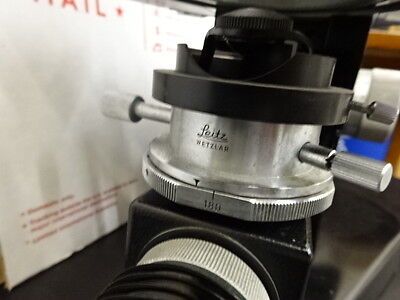
Produced by Ernst Leitz GmbH Wetzlar in Germany, this listing is for a petrographic microscope, easily identified by its inclusion of a polarizing filter and rounded, fully rotatable stage. Measuring 33 cm tall and featuring four magnification levels, 4x, 10x, 50x, and 95x, as well as an 8x magnification eyepiece, this instrument is an excellent example of its type. The serial number, 660226, as well as the size of the frame and general construction identify it as having been built in the mid-60s as part of Leitz' SM-Pol line of microscopes. The illuminator is removable and replaceable with a natural light mirror.
On Leitz Microscopes
Leitz has long been a standard name in the field of optics and optical equipment, microscopy accordingly being an essential component of the Leitz legacy. The SM-Pol line of microscopes of which this piece is a part can trace its lineage back to the 1937 introduction of the Leitz Ortholux, a landmark microscope design that offered a range of customization options, flexible lighting, and remarkable reliability. Outwardly, the trait that the Ortholux and its long line of derivatives going into the 1970s would come to be known by was their sleek, black enamel finish. The great utility of the Leitz "black enamel" line of microscopes was their relative compactness for a research microscope combined with premier optics, a fine choice of accessories, good stability for observation, and a range of models to choose from as Leitz expanded production, particularly during the 1950s and 60s. This enabled access to a high quality instrument at a reasonable price for classroom environments as well as a straightforward to use, general-purpose scientific instrument for researchers. The SM line emerged in the 1960s and is identified by its shorter base and stand producing a more compact microscope than other contemporary models such as the Laborlux or Dialux. POL is an identifier that a microscope is a polarizing type and was not a trait exclusive to the SM line.
Mineral Identification
This piece provides a compelling insight into the world of petrography and how it can be used for important tasks such as substance identification. In this case, the sample used was collected from a larger sample of chrysotile, a common mineral form of asbestos. Prepared under a slide, the subject exhibits a key feature that can be assessed with a polarizing microscope, namely, that, rotating the stage changes how the subject interacts with the light passing through it. In the case of an anisotropic mineral material like asbestos, rotation reveals the angle of extinction, or when, under cross-polarized light, the substance's optical axis becomes aligned with one of the polarized light sources and thus does not allow further transmission of light. Visually, this appears to the observer as sudden opaqueness or black color in the mineral.
Additionally, petrographic microscopes such as this can be used to observe the property of birefringence in mineral substances. This property is defined by the change in the index of refraction of the material depending on the polarization of the light hitting it. In the case of a birefringent material like asbestos, this can be visually observed by placing the sample material so as not to align with either polarizing direction in a cross-polarized light setup. Light should then pass through the material differently depending on its polarization and produce different colors, the difference of which can be tabulated to help identify the mineral.
Combined, these techniques as well as other methods of visual inspection such as analysis of material structure can be used to provide material identification of samples, something that may prove critical in the case of a hazardous substance like asbestos.
Bibliography
- "Ernst Leitz Wetzlar Company Microscope Serial Numbers." University of Toronto.
- Overney, Normand and Gregor Overney. "The Excellent Leitz Microscopes with Black Enamel Finish." 10 March 2011.
- "SM-POL Polarizing Microscope." Ernst Leitz GMBH Wetzlar. 550-13c/Engl.

























